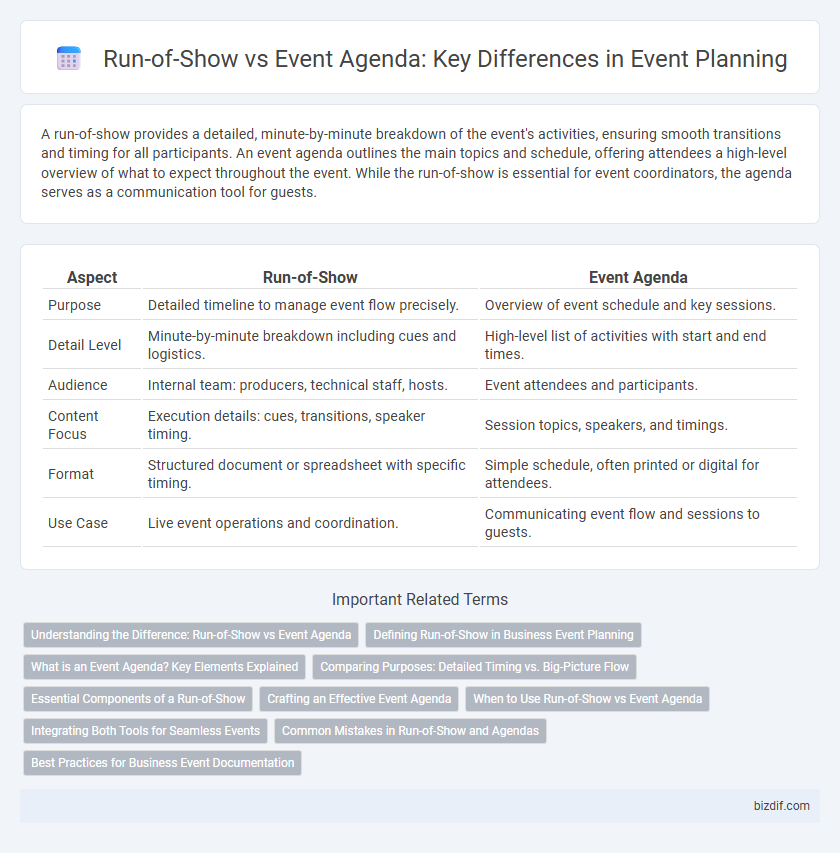A run-of-show provides a detailed, minute-by-minute breakdown of the event's activities, ensuring smooth transitions and timing for all participants. An event agenda outlines the main topics and schedule, offering attendees a high-level overview of what to expect throughout the event. While the run-of-show is essential for event coordinators, the agenda serves as a communication tool for guests.
Table of Comparison
| Aspect | Run-of-Show | Event Agenda |
|---|---|---|
| Purpose | Detailed timeline to manage event flow precisely. | Overview of event schedule and key sessions. |
| Detail Level | Minute-by-minute breakdown including cues and logistics. | High-level list of activities with start and end times. |
| Audience | Internal team: producers, technical staff, hosts. | Event attendees and participants. |
| Content Focus | Execution details: cues, transitions, speaker timing. | Session topics, speakers, and timings. |
| Format | Structured document or spreadsheet with specific timing. | Simple schedule, often printed or digital for attendees. |
| Use Case | Live event operations and coordination. | Communicating event flow and sessions to guests. |
Understanding the Difference: Run-of-Show vs Event Agenda
A run-of-show is a detailed, minute-by-minute script used by event producers and crew to coordinate timing, technical cues, and transitions, ensuring seamless execution. An event agenda provides a broad overview of key sessions, speakers, and breaks, offering attendees a clear schedule of what to expect throughout the event. Understanding the distinction between these tools enhances event management efficiency and improves communication among organizers and participants.
Defining Run-of-Show in Business Event Planning
A run-of-show in business event planning is a detailed, minute-by-minute script that outlines every segment, speaker cue, and technical transition to ensure seamless execution. Unlike a high-level event agenda, the run-of-show coordinates timing, staging, and personnel roles, serving as a critical operational guide for event staff and production teams. Precise run-of-show documentation reduces risks of delays and confusion, enhancing overall event professionalism and attendee experience.
What is an Event Agenda? Key Elements Explained
An event agenda is a detailed schedule outlining the sequence of activities, sessions, and breaks during an event, serving as a roadmap for attendees and organizers. Key elements of an event agenda include the start and end times, session titles, speaker names, locations, and allocated durations for each segment. Precise agendas enhance time management, attendee experience, and overall event flow coordination.
Comparing Purposes: Detailed Timing vs. Big-Picture Flow
Run-of-show documents provide detailed timing and specific instructions for each segment of an event, ensuring seamless transitions and precise execution. Event agendas outline the big-picture flow, highlighting key sessions and overall structure to guide attendees through the event experience. Understanding the distinction between these tools is vital for effective event planning and coordination.
Essential Components of a Run-of-Show
A run-of-show is a detailed script that outlines every moment of an event, including timing, speaker cues, and technical instructions, ensuring flawless execution. Unlike a general event agenda, it includes backstage and production details such as AV setups, transitions, and contingency plans. Essential components of a run-of-show include precise timestamps, role assignments, and clear communication protocols to keep the event on track from start to finish.
Crafting an Effective Event Agenda
Crafting an effective event agenda requires balancing detailed timing with clear activity descriptions to ensure smooth event execution. A run-of-show provides a minute-by-minute breakdown mainly for production teams, while the event agenda offers attendees an accessible overview of sessions and keynotes. Prioritizing clarity and time allocation in the agenda enhances attendee engagement and streamlines event flow.
When to Use Run-of-Show vs Event Agenda
The run-of-show is essential for detailed event execution, outlining every moment from start to finish, ideal for internal teams managing production and timing. The event agenda provides a high-level overview of sessions and key activities, suited for attendees to understand the event flow. Use the run-of-show during rehearsals and live event management, while the event agenda is best distributed in advance for guest planning.
Integrating Both Tools for Seamless Events
Integrating a run-of-show with an event agenda ensures a seamless event flow by combining detailed timing and task management with high-level scheduling. This fusion allows event planners to coordinate logistics and communicate agendas clearly to participants. Utilizing both tools enhances real-time adjustments, improves communication among teams, and elevates attendee experience through precise execution.
Common Mistakes in Run-of-Show and Agendas
Confusing a run-of-show with an event agenda often leads to common mistakes such as neglecting detailed timings and task assignments in the run-of-show, causing coordination issues during the event. Event agendas typically outline the schedule and topics, but failing to integrate logistical details and personnel responsibilities results in execution gaps. Clear differentiation and precise content tailored to each document prevent miscommunication and ensure smooth event flow.
Best Practices for Business Event Documentation
Run-of-show documents provide a minute-by-minute breakdown of event timing, ensuring precise coordination among staff and speakers, while event agendas offer a broader overview of sessions and key activities. Best practices for business event documentation include integrating both formats to enhance clarity, using digital tools for real-time updates, and ensuring all stakeholders have access to the most current versions. Clear, detailed run-of-show and agendas minimize confusion, improve communication, and contribute to the overall success of business events.
Run-of-show vs event agenda Infographic

 bizdif.com
bizdif.com